"Layout settings" tab for Primefire 106 presses
The options available in this tab are matched to the Primefire 106 press. This means that options that do not suit this press model are not offered for selection. Other options are matched accordingly.
Note: For Primefire 106 presses, the trimmed size is generally taken from the PDF documents.
"Paper" list box
The width and height of a substrate display when you select this substrate. The following is valid for sheetfed digital presses: The substrate sheets shown in the layout section display in the orientation that the sheets have on the press, as seen when standing in front of the press. Then the sheets run through the press from right to left. Accordingly, the "Width" value refers to the dimension of the paper in the direction of travel and the "Height" value to the dimension of the paper perpendicular to the direction of travel.
"Output Condition" list box
This is where you select the output condition defined for the paper used (see Machine setup using output conditions).
You can set up the number of columns and rows on the subject and, if necessary, repeats using the "Columns" and "Rows" parameters and the "Repeat" option.
This is where you define the number of 1ups/folding sheets on the press sheet.
You always start off with one folding sheet per press sheet. In other words, folding sheet 1 is placed on press sheet 1, folding sheet 2 on press sheet 2, etc.
The "Repeat" option only has an effect if the "Rows" or "Columns" box contains a number equal to or greater than "2".
•"Rows" without "Repeat"
The "Rows" and "Columns" boxes each contain the number 1 and the "Repeat" options are not enabled:

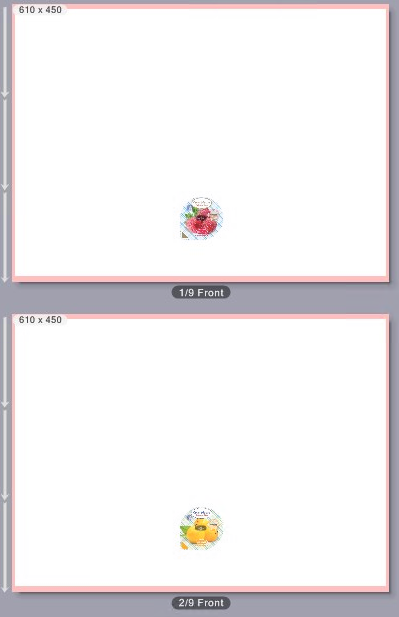
A different subject or folding sheet is placed on each sheet.
Now enter a "2" in the "Rows" box. The "Repeat" options are disabled.
Subjects 1 and 2 are then placed one below the other:

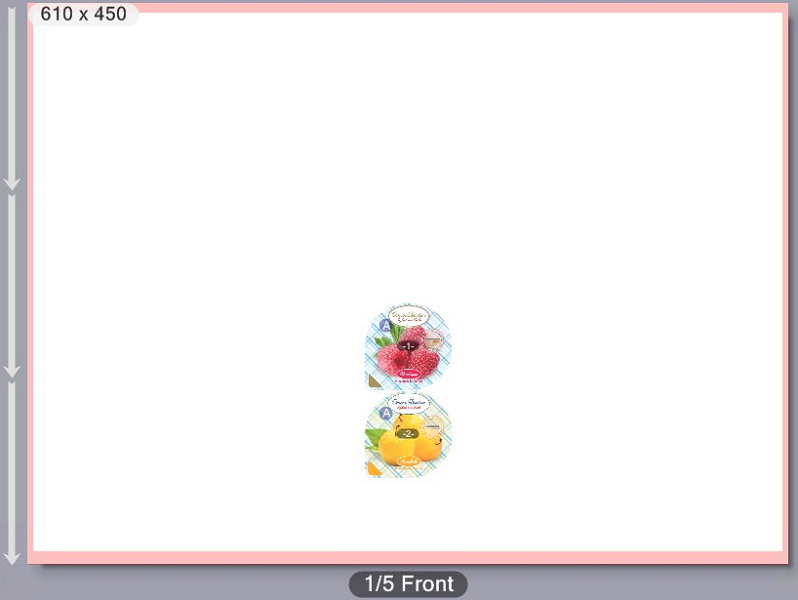
•"Rows" with "Repeat"
Enter "2" in the "Rows" box and enable "Repeat".
Two subjects of the same kind are placed one below the other.

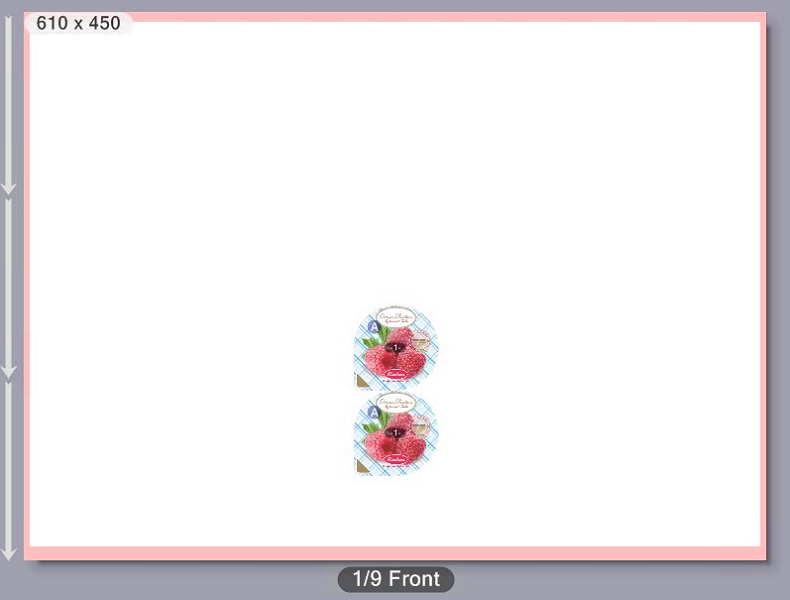
•Rows and columns with Repeat.
Enter a "2" in each case in the "Rows" and "Columns" boxes. The "Repeat" options are enabled.
Four subjects of the same kind are placed on each sheet.


"Rotation" option (angle sign)
In this list box, you can set a rotation angle for all pages/folding sheets placed on the surfaces. In doing so, the page content is rotated too.
Rotation angles 0°, 90°, 180° or 270° in clockwise direction are available.
Note: Orientation of the pages is tagged by "A" icons if you select the "Layout" view in the preview.
"Vertical/horizontal distance" options
With these options you can set up the vertical and/or horizontal spacing between the pages or folding sheets.
|
|
Vertical spacing between folding sheets.
|
|
|
Horizontal spacing between folding sheets. |
Custom folding sheet settings for spacing and rotation angles
If a number greater than "1" is entered in the "Columns" and/or "Rows" boxes, a graphic displays in the lower part of the "Layout settings" tab where you can individually set the orientation of the single folding sheets and the spacing between the folding sheets.
When you click an object in the graphic, you can edit the orientation of this folding sheet. This orientation displays in the preview pane.
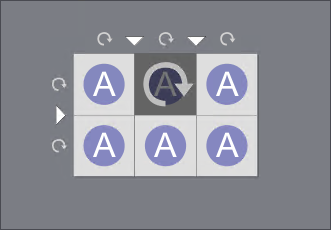
These rotations rotate the single objects on a surface.
In contrast to this, you set the orientation of all objects placed on a surface using the rotation angle settings from the list box.
Example: A carton is placed several times on a surface. Parameters: Columns = 2, Rows = 2, Repeat = On. The "Layout" preview is set.
Rotation angle setting = "0°", the top right carton in the graphic is rotated:
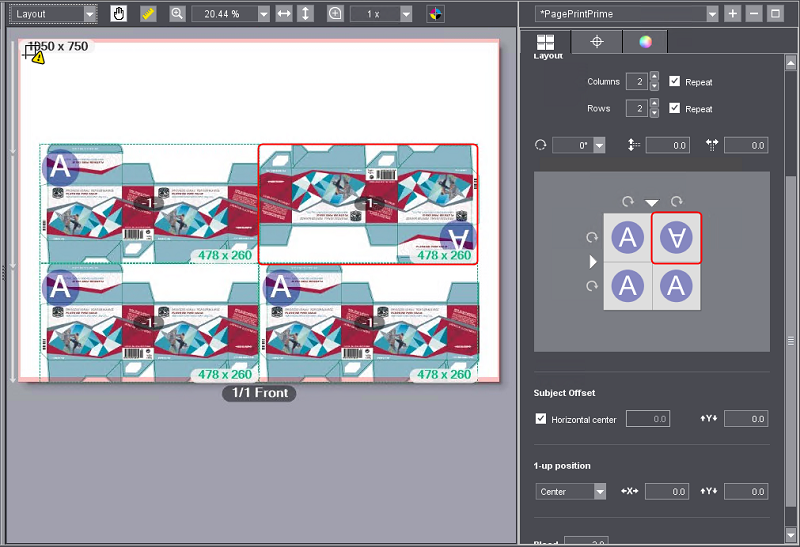
Rotation angle setting "90°", the top right carton in the graphic is rotated:
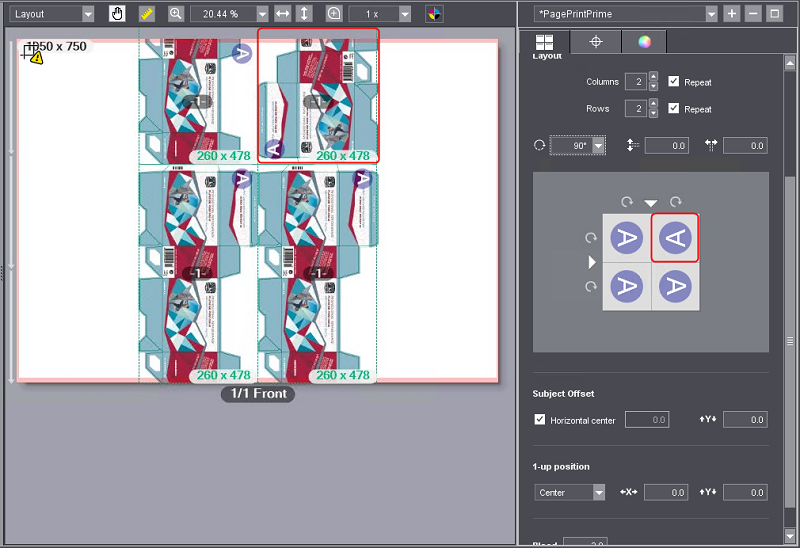
The whole arrangement of the cartons is rotated by 90°, the top right carton is rotated by 180° compared to the other cartons as seen in the graphic.
The setting of the rotation angle in the list box rotates the entire arrangement of the objects on the press sheet. Rotations that you define by clicking in the graphic affect the rotation of single objects in relation to the other objects.
"Subject Offset" section
In the input boxes, you can set the horizontal and vertical offset of the subject to the reference point in the bottom left corner of the press sheet. The box for the horizontal offset is dimmed if "Horizontal center" is enabled.
"Horizontal center" option
When you enable this option, the subject is centered horizontally on the sheet.
"1up position" section
In this section, you can orientate the position of a 1up (e.g. a label) precisely compared to the related folding sheet. In this process, the trim box of the 1up is matched to the folding sheet. Editing this is necessary only if the sizes of the 1ups are different and/or if the1up positions do not exactly match the folding sheets. Proceed as follows:
1.Select the "Sheet" view in the preview and select a zoom factor that lets you detect the details of the objects accurately enough.
2.Select "Show > Boxes / Dimensioning" in the context menu of the preview pane.

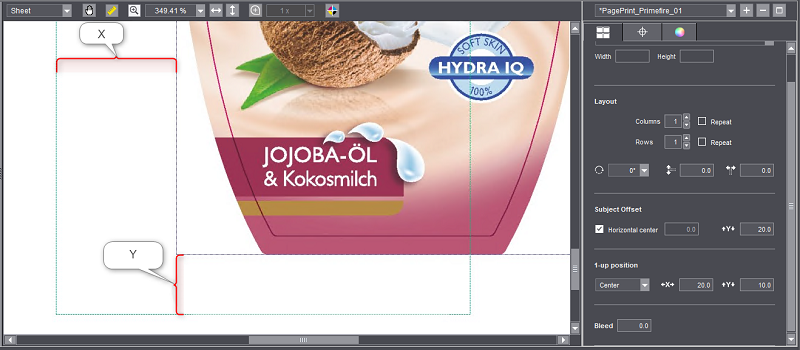
3.Now in the list box in "1up position" select whether you wish to orientate the 1up centered or on the bottom left corner of the cutting die.
4.In the boxes for offset in X and Y direction, now enter offset values until orientation of the 1ups exactly matches the folding sheet. You can also enter negative values in the boxes. The change displays in the preview when you change your input focus or hit the Tab key.
You can define a dimension for the bleed in the "Bleed" box.
The "Bleed" determines the maximum width that will still be printed outside the page trim box. For example, if a bleed of 3 mm is set, a border 3 mm wide will be printed outside the page trim box, even if a larger content area outside the trim box is defined in the PDF.